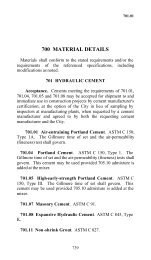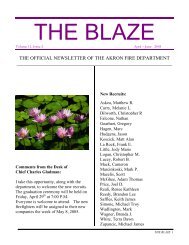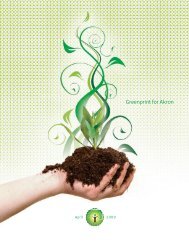Akron Water Pollution Control Station No Feasible Alternative
Akron Water Pollution Control Station No Feasible Alternative
Akron Water Pollution Control Station No Feasible Alternative
Create successful ePaper yourself
Turn your PDF publications into a flip-book with our unique Google optimized e-Paper software.
<strong>Alternative</strong> 3A will include four (4) new, 42.5 MGD high-rate treatment processes to<br />
provide clarification/filtration of final settling tank overflow plus the necessary hydraulic<br />
improvements up to 170 MGD. Refer to Figure 4-4.<br />
<strong>Alternative</strong> 3B will include five (5) new, 42.0 MGD high-rate treatment processes to<br />
provide clarification/filtration of final settling tank overflow plus the necessary hydraulic<br />
improvements up to 210 MGD. Refer to Figure 4-5.<br />
<strong>Alternative</strong> 4 – Membrane Filtration<br />
This alternative considers the application of wastewater membrane technology to filter the<br />
mixed liquor effluent from the aeration basins to provide the necessary additional clarification<br />
capacity. The membrane filters would work in concert with the existing final settling tanks.<br />
Based on a review of this concept with two leading manufacturers, it is proposed to locate the<br />
membranes in separate, new tanks north of Aeration Basin <strong>No</strong>. 6. The required pumping and<br />
piping systems would be similar to <strong>Alternative</strong> 2. Use of membranes will require fine screening<br />
of primary effluent and primary effluent pumping. A two or three millimeter screen size is<br />
recommended. Because of the additional hydraulic head required for this alternative, it will be<br />
necessary to significantly modify the secondary influent flow splitting chamber (Aeration Influent<br />
Flume). The aeration basin walls will be raised. Two capacity increase increments were<br />
evaluated.<br />
<strong>Alternative</strong> 4A will include two membrane filtration tanks to provide 40 MGD additional<br />
solids separation capacity plus the necessary hydraulic improvements and a new Fine<br />
Screening and Pumping Facility, for a total secondary treatment capacity of 160 MGD. Refer to<br />
Figure 4-6.<br />
<strong>Alternative</strong> 4B will include four membrane filtration tanks to provide 80 MGD additional<br />
solids separation capacity plus the necessary hydraulic improvements and a new Fine<br />
Screening and Pumping Facility, for a total secondary treatment capacity of 200 MGD. Refer to<br />
Figure 4-7<br />
Group 5 <strong>Alternative</strong>s – Membrane Bioreactor (MBR) Facility<br />
The aeration basins would be converted to membrane bioreactor tanks in this alternative.<br />
Because MBRs function with a much higher mixed liquor suspended solids concentration<br />
(approximately 10,000 mg/l), not all of the six aeration basins will be needed. A new fine<br />
screening (two to three millimeter) facility would be located upstream of the MBR tanks following<br />
primary treatment (primary settling tanks will remain in service in order to maintain the current<br />
sludge process train). To accommodate the headloss imposed by the fine screens, and provide<br />
a deeper tank depth as required for the MBR equipment, it is proposed to pump primary effluent<br />
to the new fine screening and MBR facility. Because the Cuyahoga River 25-year flood<br />
elevation impacts WPCS effluent hydraulics, a primary effluent pumping station will also be<br />
required. Permeate pumps will draw mixed liquor through the membranes and discharge the<br />
filtrate to the secondary effluent conduits. Piping galleries will be required between<br />
compartmentalized sections of the modified aeration basins to provide space and access to<br />
influent and effluent piping and to access the permeate pumps. Two capacity increase<br />
increments were evaluated.<br />
<strong>Alternative</strong> 5A will include the conversion of three (3) aeration basins into MBR tanks<br />
with an average day capacity of 90 MGD and a maximum day capacity of 170 MGD. A primary<br />
Page 4-8







